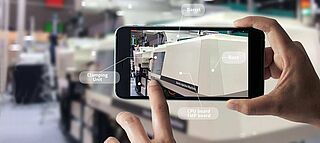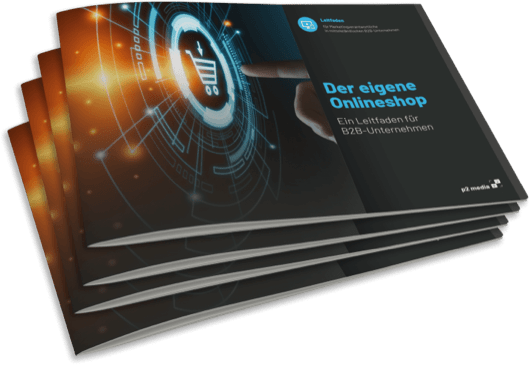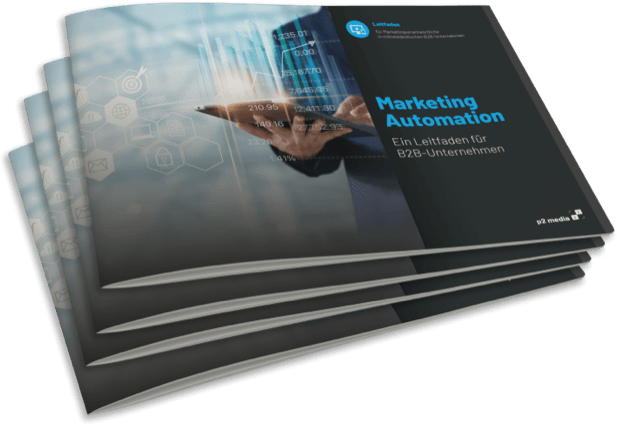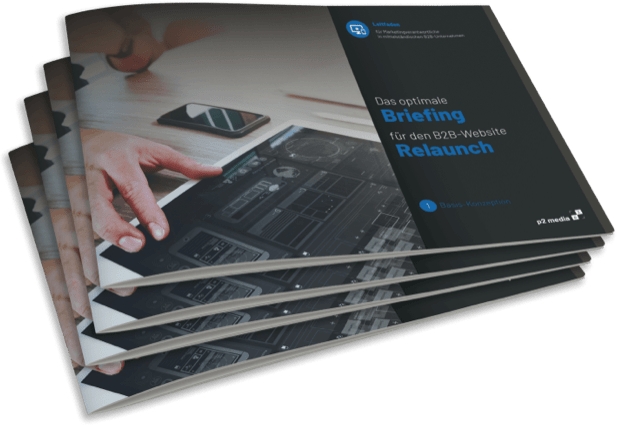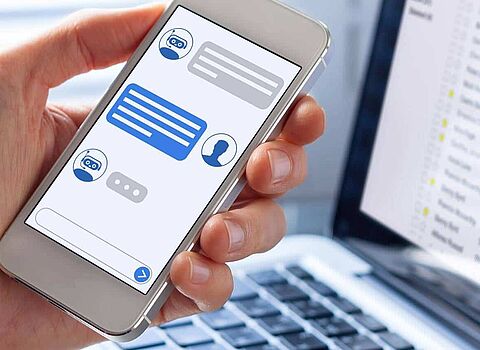The web and with it the expectations of internet users as well as online marketing are subject to a constant genesis. Especially in B2B, the numerous resulting - sometimes highly promising - possibilities as well as the associated requirements are only slowly being realized in many places. Quite a few small and medium-sized businesses still rely exclusively on static online information about companies and products. Today, increasingly important terms or corresponding processes between marketers and users, such as the customer experience, mobile e-commerce, video, 3D design, animations, artificial intelligence (AI), voice user interface (VUI) design, etc., have yet to be established here. Why the adoption of these and other modern marketing features is absolutely necessary in B2B as well as even in smaller companies and which trends are emerging for B2B websites in the first half of 2023, you can read in this guide.
Why is the consideration of modern online marketing
measures so important for B2B websites?
It's a fact that today, as soon as your (potential) B2B customers identify a problem or a need, they also start searching online for the corresponding solutions. The web has long since largely replaced classic research channels such as trade journals or physical business directories. Accordingly, it is important to convey an optimal impression of your brand there. In this context, the corporate website or the possibly associated e-commerce solution with suitable content still forms the centre of the marketing measures. Today, the latter must by no means be oriented as a static self-presentation. Your (potential) customers want to be addressed as personally as possible and, above all, feel understood in their challenges or wishes. You can no longer achieve this by exclusively highlighting the advantages of your company and your products. More or less flat advertising messages are - mainly due to the generally enormous increase of promotional playouts in the last 20 years - mostly simply ignored or, in the case of ads, excluded by ad blocker software. Advertising and especially ads can still be very successful in online marketing, but not on their own.
Rather, you need to provide content that adds real value to your (potential) customers, i.e. that really helps them on their way to solving their problems or needs. This is what today's marketing trends are all about. By embracing this, you will benefit on numerous levels, as the following description of the first 2023 trend - Customer Experience - specifically shows.
Customer Experience
The customer experience and its close relative the user experience can be seen as all-embracing factors for successful (online) marketing in 2023. The customer experience encompasses the entire customer experience that a (potential) customer has with your brand - both online and offline. This concerns all touchpoints - from the firstcontact, for example via a Google Ad, to your appearance within your company website, to the purchase of one of your goods or services and the support beyond that.
Your brand must be apparent and positively experienced by (potential) customers at every touchpoint during their customer journey. If your target group experiences an all-round affirmative buying experience within your website, a positive customer experience will result. To achieve this, the Customer Experience, must absolutely focus on the (eventual) buyer and their challenges or needs. If possible, try to provide a suitable brand touchpoint for every problem that can be solved with your goods or services, or every desire that can be fulfilled. At best, even exceed the expectations of your target group. Optimally, you will also clearly set yourself apart from your competitors in this way. You thus make your brand attractive to your target group and ultimately perhaps indispensable, which of course strengthens the customer relationship enormously.
In addition, the major search engines also register a good or bad customer experience and evaluate it for the classification of pages in their rankings. Unique, constantly adapted content is of great SEO relevance. Since today a significantly large part of your (potential) customers access your web offers via Google and Co. or become aware of them, this connection is enormously important.
All of the following trends and modern online marketing in general focus
-among other things and often quite specifically-
on creating an optimal customer experience.
3D design and digital illustrations in general are among the hottest graphic design trends at the moment. They have marketing relevance, among other things, because they are always unique and thus help your company to stand out clearly from the competition. In B2C, illustrations promote emotional communication between a brand and (potential) customers, which is always beneficial for long-term business relationships. In B2B, such processes are hardly evident due to the usually much more rational buying behaviour - nevertheless, 3D design in B2B web design can fulfil various important functions.
Digital (3D) illustrations give your B2B company more personality. They are an expression of your creativity and stand for innovative strength. In addition, a B2B website naturally stands out from the competition in e-commerce through 3D design. With the help of appropriate features, you can increase the quality of the customer experience enormously - especially if a real added value is conveyed. Due to the less emotional, primarily rational buying behavior in B2B, the highest possible added value content is in fact elementarily decisive for success when using 3D design.
Similar to digital 3D illustrations, animations also bring an individual touch to B2B websites. Beyond that, however, you should always convey real added value through the use of such means. For example, animation can be used to demonstrate complicated concepts and convey information about goods or services in an easy-to-understand way.
Animations are most often found in the form of microinteractions (more on this below) as part of the navigation. There they underline important functions, clarify the contents of pages already in the respective menu item or show users where they are currently located.
But they can also be used - and in a much more sophisticated way - to breathe more life into a B2B website and to inspire (potential) customers for innovative, creative approaches that your company has in store. For example, it is possible to create an animated guide to help users of your website with relevant information on all business matters.
Furthermore, an animated sequence can visually demonstrate the interaction between customers and your company or your business processes or production methods. Or you can produce a short animated video with central facts about your company - and facts that are necessarily particularly important for your (potential) customers - and place it as an animation in certain places on your website.
A corresponding approach also offers opportunities with regard to explanatory videos. In small precisely coordinated sequences, for example, the correct use of a product can be described together with written supplements without having to watch a longer video. Consequently, animations offer a particularly useful way of structuring content, which sometimes has a very positive effect on the customer experience.
Microinteractions are - as the name already largely describes - small, discreet animations whose effect on the users of a B2B website, however, should not be underestimated. In the form of menu hover effects or drop-outs, they bring increased functionality on several levels. The latter features in particular can provide improved usability on mobile devices, which are popular today and have significantly smaller displays than desktop devices. This in turn increases the customer experience. But it can also be more complex. For example, a change of viewpoint in the course of viewing pro and con lists is possible, which visually underlines the different points of view. The transition between microinteractions and animations is often fluid. Both have a clear goal: they should make the stay on your website more pleasant under the basic condition of providing real added value. Microinteractions are also able to eliminate potentially negative user experiences. If, for example, the loading time of content is not optimal, this is skilfully concealed with a microinteraction (whereby the simplest and best-known, but by no means most expedient variant is the running hourglass). Likewise, they can help distract from other now-and-then problems. All in all, microinteractions give your users the impression of having "more control" in the browsing process or of always knowing what is happening, which of course significantly increases the customer experience.
According to QuoraCreative, 40 percent of people now use mobile voice search at least once a day. As many as 20 percent say they use voice search features once a month. This is far from exclusive to younger internet users - of those aged 55-64, 9 percent use voice search regularly. These figures clearly show that the trend towards voice search absolutely must be incorporated into every company's online marketing strategy.
The question is: How can voice user interface (VUI) design be best implemented/considered on the B2B website? Of course, you have the option to launch a website-internal voice search function and/or have a chatbot act voice command-based. At the base, however, it is first necessary to consider the behaviour of your (potential) customers in terms of voice search at Google and Co., i.e. to optimally adjust your content to it and not least the algorithms of the search engines. Since the majority of voice searches concern typical topic-related questions, you need to elicit these in particular and provide your target group with the right answers to them. All of this should be done in the natural language of your (potential) customers and using the right keywords.
AI elements - especially in the form of chatbots - are already present on many B2B websites. The integration of such largely self-acting features is likely to increase sharply, making them more and more part of your target group's expectations. When it comes to B2B web design, Artificial Intelligence primarily aims to improve the customer experience.
The example of chatbots makes this particularly clear. With the help of a chatbot that is responsive 24/7, you convey an outstanding service to your (potential) customers - and this is of course particularly relevant in B2B, where it is not uncommon for complex products and the associated significant investments to be involved.
At the same time you save your human resources and give your (support) staff the chance to take care of very important matters more intensively. Because standard processes are increasingly being taken over by the AI solution.
The high marketing relevance of the personalization of web content has already been established for several years. Today and in the future, however - among other things, because (potential) customers increasingly expect to be addressed personally - it will become more and more crucial to success to take corresponding facts into account. Through e-commerce content that is precisely tailored to personal challenges or needs, an individual approach within log-in areas and/or a personalization of product offers in your online shop, you give your customers the now so important feeling of being truly understood.
Customers who feel that their identity and preferences are taken into account across all touchpoints with a business are not only very likely to buy from the applicable business, but also tend to remain loyalto it in the long term.
It's in this marketing space, by the way, that artificial intelligence can really come into its own. With the help of AI-based automation solutions, a highly targeted, efficient personalization of e-commerce content is possible.
The popularity of video content is enormous. In B2B, too, people prefer to watch videos rather than read texts in many contexts. No wonder, because videos are easy to record when used in the right marketing-specific way, offer the perfect basis for presenting even the most complex issues in a way that is easy to understand and also have a high persuasive potential, among other things, due to the personal appearance of the company playing them out in the form of influencers.
These positive characteristics are even increased with live videos. Here, (potential) customers receive an incomparably authentic impression of a brand and the people behind it. In addition, there is the possibility of offering participants in such a live broadcast the chance to interact directly with the protagonists. Here, the positive brand perception and long-term business relationships are de facto enormously favored.
Augmented reality, i.e. the transfer of digital objects into the real world on a virtual level or with the help of portable digital devices, was primarily used very successfully in video games in the past. Thanks to the continuous development of mobile technology, such possibilities are also becoming more and more interesting for B2B websites.
For example, furniture giant IKEA shows how augmented reality can work in a business context. Here, app users are given the opportunity to see how a piece of furniture will look in their home via their smartphone even before they buy and assemble it. In the B2B sector, such features can be offered, for example, to show prospective customers of a manufacturing plant whether it will fit in their premises without cumbersome measuring.
Also B2B, many business transactions already take place online via specific shops. These - and of course all other web offers provided - must be optimally mobile usable today. Just as in B2C, the number of users of portable devices in B2B is constantly increasing and is already well over the 50 percent mark.
Google has given mobile versions of websites increased priority under the mobile-first approach for several years now. In fact, only mobile versions are now considered for indexing. Considering the fact that a large part of your (possible) customers will reach your B2B website via the search engine prime, this is of course extremely relevant.
Using digital trends profitably:
- In order to increase your own competitiveness, a digital strategy is necessary - we will gladly advise you with an open mind and support you in the decision-making process.
- In this step, we would also be happy to conduct a status analysis of your previous digital activities and jointly develop a digital guide for the optimization of your digital strategy.
- Our years of extensive experience enable us to implement adigital strategy in a targeted manner, through implementation and performance measurement to daily support.
We are also happy to support you with the following topics:
Oliver Parrizas will be happy to answer any questions you may have on the subject. +49-800-911-91-91
